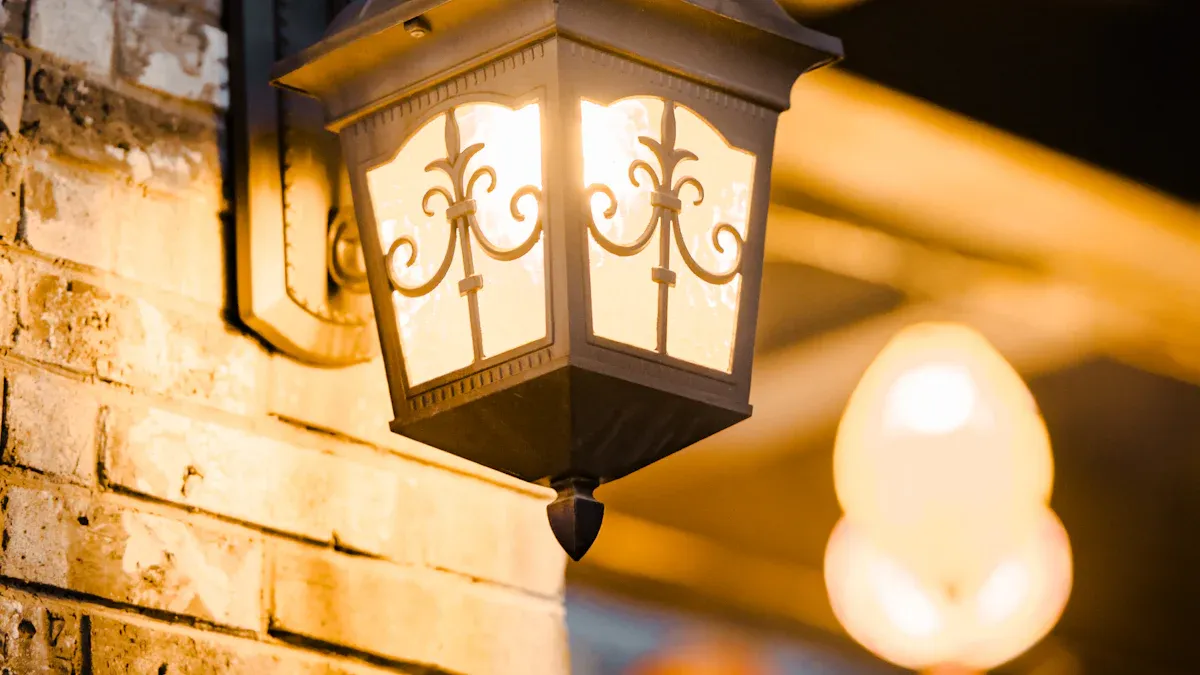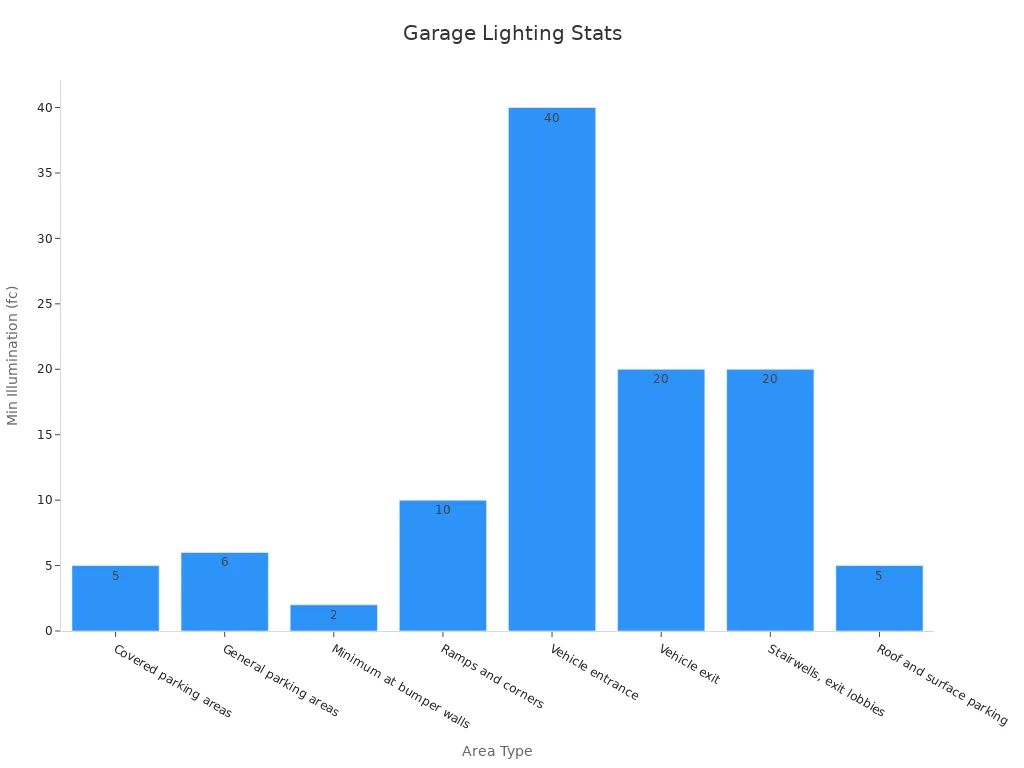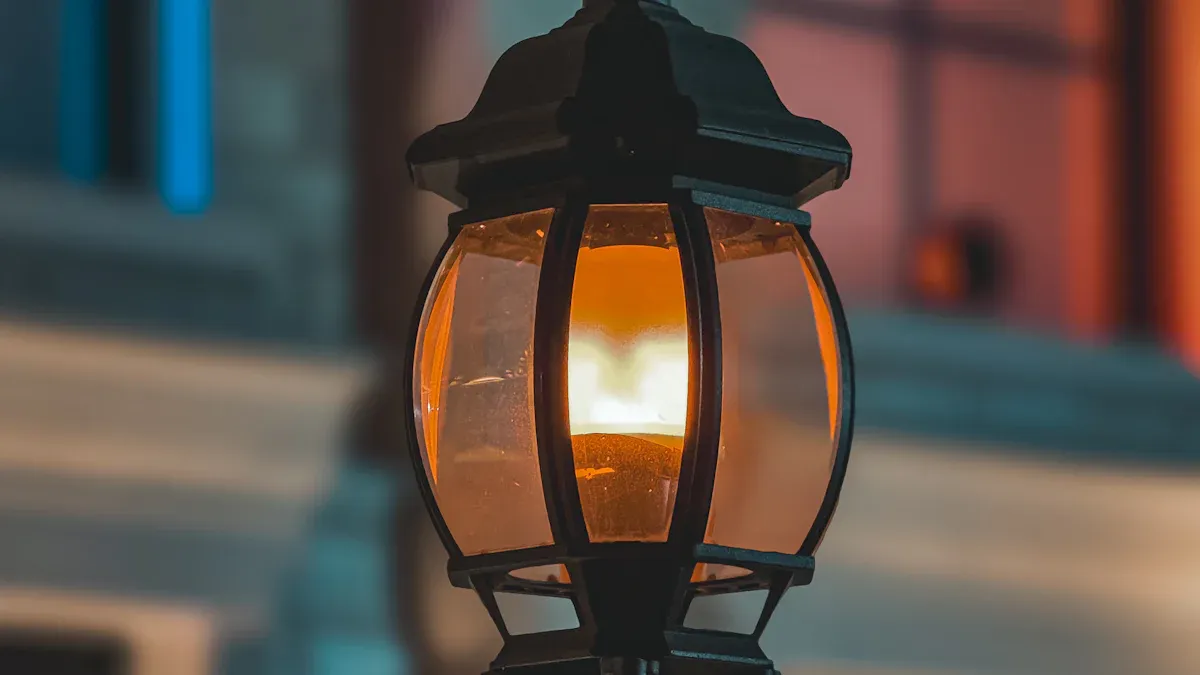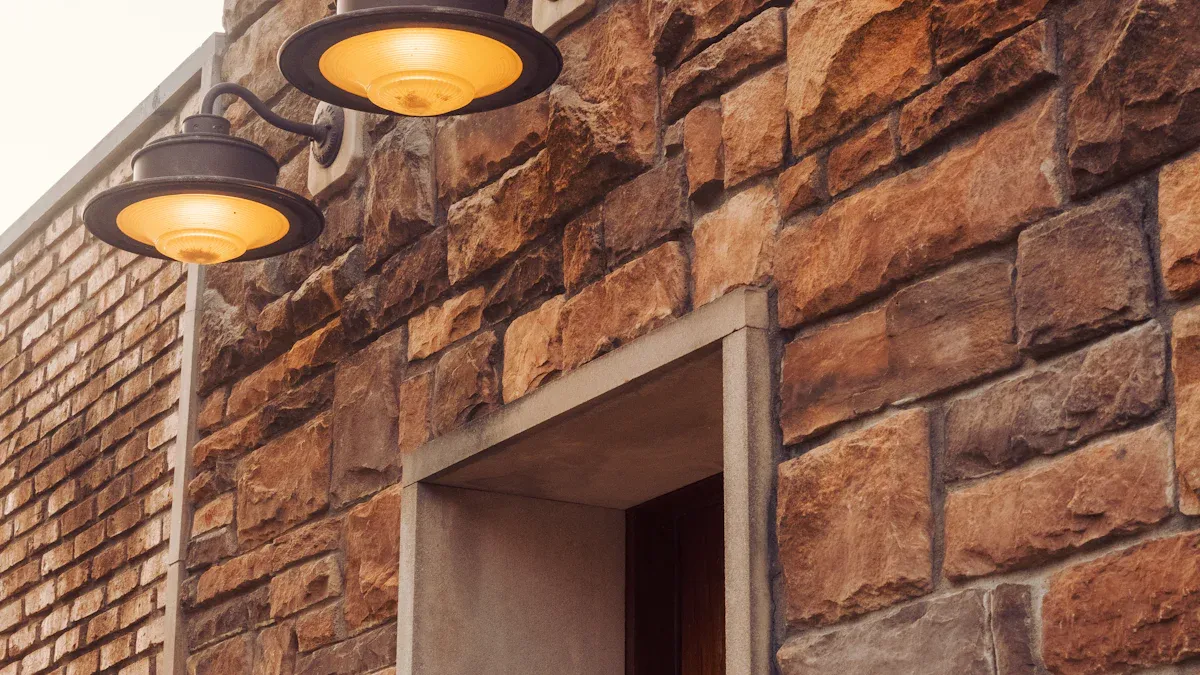How to Choose the Perfect Garage Outdoor Light

Choosing the right garage outdoor lighting isn’t just about looks—it’s about safety, practicality, and making your home shine. The right light can help you see better when parking at night, deter intruders, and even boost your curb appeal. You’ll want something that’s not only functional but also energy-efficient and long-lasting.
Did you know that LED lights consume up to 70% less energy than traditional bulbs? Plus, they can last up to 100,000 hours, saving you time and money on replacements. A high-quality LED model could even save you up to $325 in lifetime energy costs. When you’re thinking about the best product for your garage, don’t forget to consider the size of the space and where the light will go. That way, you can choose the perfect garage light that fits your needs.
Key Takeaways
Pick LED lights for your garage. They use less energy, last longer, and cost less to replace.
Think about your garage's size and shape when choosing lights. Good placement gives even light and keeps it safe.
Try motion sensor lights for extra security. They turn on when they sense movement, scaring off intruders.
Choose weatherproof fixtures to make them last longer. This stops frequent fixes and keeps your garage bright.
Focus on saving energy. Low-power LED lights cut energy bills but still shine brightly.
Understanding Your Garage Lighting Needs
Purpose of Garage Outdoor Lighting
Think about why you need garage outdoor lights. Do you want better safety, lower energy bills, or easier use? Each goal needs a different type of light. For example:
Purpose | Description |
|---|---|
Lights turn on only when needed, saving power and money. | |
Security | Bright lights scare away intruders and make areas safer. |
Convenience | Hands-free lights are helpful when your hands are full. |
If safety is your top concern, motion-sensor lights are ideal. They turn on when someone gets close, which can scare off trespassers. For saving energy, LED lights are the best choice. They use less electricity and last longer than regular bulbs. If you want convenience, try smart lights. You can control them with your phone to adjust brightness or turn them on and off easily.
Good lighting also makes you feel safer. Studies show that while lights don’t always stop crime, they help people feel more secure. A bright garage can give you peace of mind, especially at night.
Assessing Garage Size and Layout
The size and shape of your garage matter when picking lights. A small garage might need one or two lights. Bigger garages with more doors need extra fixtures. Match the lights to the needs of each area.
Here’s a simple guide for how bright lights should be:
Area | Minimum Lighting (lux) | |
|---|---|---|
Parking Spaces and Driveways | 5 | 54 |
Entrances and Exits | 10 | 108 |
Stairwells and Elevators | 7.5 | 80 |
Payment Stations | 10-15 | 108-161 |
For example, entrances and exits need brighter lights so you can see clearly when driving in or out. Stairwells and elevators need good lighting to avoid accidents.
Think about your garage layout when planning lights. Are there dark spots or hard-to-see areas? These places might need extra lighting. Also, consider the height of your garage. Taller garages may need stronger lights or adjustable fixtures to cover all areas evenly.
If you’re unsure how much light you need, aim for at least 5 foot-candles (fc) for parking areas. For ramps, corners, or entrances, you might need up to 40 fc.

By thinking about your garage’s size and layout, you can pick the right lights. This way, every part of your garage will be bright, safe, and easy to use.
Types of Garage Outdoor Lighting

LED Lights: Benefits and Drawbacks
LED lights are a top pick for garage lighting. They save energy, using 90% less power than old bulbs. They also last a long time—about 25,000 to 30,000 hours. This means you won’t need to replace them often, making them great for outdoor use.
LEDs are tough and work in extreme weather. They resist shocks and vibrations, too. While they cost more at first, they save money over time. Their energy efficiency and low upkeep make them worth it.
If you want stylish and useful lights, LEDs are a great choice. They come in many designs to match your home. They also light up large areas, keeping your garage bright and safe.
Incandescent and Fluorescent Options
Incandescent and fluorescent lights are older but still useful. Incandescent bulbs are cheap and give warm light. But they don’t save energy and only last about 1,000 hours. Fluorescent lights last longer—up to 9,000 hours—and use less energy.
Here’s a quick comparison:
Lighting Type | Energy Efficiency (%) | |
|---|---|---|
Incandescent | 1,000 | 0 |
Fluorescent | 9,000 | 70 |
LED | 25,000 - 30,000 | 90 |
Fluorescent lights are a good middle option if you’re not ready for LEDs. They work well for general lighting but may not last as long outdoors. If you pick these, make sure they’re made for outdoor use.
Spotlighting vs. Floodlighting
You’ll need to choose between spotlights and floodlights. Spotlights focus on small areas, like your garage door or driveway. Floodlights spread light over wide spaces, giving better overall brightness.
Here’s a comparison:
Characteristics | Flood Light | Spotlight |
|---|---|---|
Distribution and Form of Illumination | Wide light spread | Focused light beam |
Lumens | 700 to 1300 | 50 to 300 |
Beam Angle | 40 - 120 degrees | 10 - 30 degrees |
Floodlights are best for lighting large areas. Spotlights are better for focused lighting, like boosting security near your garage. Both can work with motion sensors for extra safety and ease.
Choosing Energy Efficiency and the Best Wattage for Outdoor Garage Lights
Energy-Saving Lighting Options
Garage lights that save energy are a smart choice. They light up your space without costing too much. LED lights are the best for this. They use 70% less energy than regular bulbs. This makes them the most efficient option for garages. LEDs also give steady light, so no flickering or dimming happens.
LEDs last much longer than other lights. They can work for up to 100,000 hours. This means you won’t need to replace them often. Think about not changing a bulb for years! They also give bright light with lower wattages. This saves electricity and lowers your energy bills.
For even more savings, try low-wattage, high-efficiency LED lights. These can cut energy use by over 80% compared to old bulbs. You’ll save money and help the environment at the same time. It’s good for you and the planet.
Ideal Wattage for Garage Lighting
Picking the right wattage is important for garage lights. The size of your garage decides how much wattage you need. Here’s a simple guide:
Light Type | Small Areas (Up to 200 sq ft) | Medium Areas (200-400 sq ft) | Large Areas (400+ sq ft) |
|---|---|---|---|
LED Lights | 15-30 watts | 30-50 watts | 50-80 watts |
Incandescent Lights | 60-100 watts | 100-150 watts | 150-300 watts |
Fluorescent Lights | 20-40 watts | 40-60 watts | 60-80 watts |
Small garages need LED lights between 15-30 watts. Medium garages may need 30-50 watts. Bigger garages might need up to 80 watts. If you use incandescent or fluorescent lights, you’ll need higher wattages for the same brightness.
Think about your needs when choosing wattage. Do you want bright lights for safety or softer ones for looks? LEDs let you pick the right mix of brightness and energy savings.
By choosing the right wattage, your garage will be bright, safe, and energy-efficient. Whether parking, working, or grabbing something, good lighting makes everything easier.
Ensuring Durability and Low Maintenance
Weather-Resistant and Wet-Rated Fixtures
Outdoor garage lights must handle tough weather. Rain, snow, and dust can harm weak fixtures. This causes frequent repairs or replacements. That’s why weather-resistant and wet-rated lights are important. These lights stay strong in bad weather, keeping your garage bright.
Check the IP rating to choose the right light. The IP rating shows how well it blocks dust and water. Here’s a simple guide:
IP Rating | Dust Protection | Water Protection | Best Uses |
|---|---|---|---|
IP54 | Blocks some dust | Stops water splashes | Indoor spaces with little moisture |
IP65 | Blocks all dust | Handles rain and water jets | Outdoor areas with rain exposure |
IP67 | Fully dustproof | Handles short water submersion | Wet places like docks or flood-prone zones |
For most garages, IP65-rated lights are ideal. They block dust and resist rain easily. If your garage floods often, pick IP67-rated lights for extra safety.
Long-Lasting and Easy-to-Maintain Lights
Strong lights save money and time. Materials like copper and brass last longer. They resist rust and damage in harsh weather. Though they cost more, they can last over ten years. Cheaper lights often need repairs or replacements sooner.
Energy-saving lights also cut costs. LEDs use less power and last up to 100,000 hours. This means fewer replacements and lower bills. They also stay bright without flickering or dimming.
Choosing durable, low-maintenance lights is smart. You’ll save on repairs and keep your garage looking great. It’s good for your budget and peace of mind.
Selecting the Right Size and Placement

Proportional Sizing Guidelines
Picking the right size for garage lights is about balance. Lights that are too big can look awkward. Lights that are too small may not shine enough. Use your garage door’s height to decide the size.
Choose lights that are one-third or one-quarter the height of your garage door for a neat look.
For single doors, multiply the width by 0.25 to find the best size. For double doors, use 0.33 instead.
If using more than one lantern, each should be one-fourth the door’s height. For one lantern, pick a size closer to one-third the door’s height.
These rules help your lights look balanced and improve your home’s style. They also stop you from picking lights that are too small for the area.
Placement Tips for Optimal Illumination
Where you put your lights is just as important as their size. Good placement removes shadows and keeps your garage bright. Measure your space to figure out how many lights you need. Most homes need 2-5 lights, while bigger garages may need more.
Follow these tips for better lighting:
Space lights evenly to avoid dark spots and get even brightness.
Use lights from different angles to spread light evenly and stop shadows.
Overlap light areas slightly to avoid dim spots.
Place lights where trees or roofs won’t block them.
Key Point | Description |
|---|---|
Recommended Lumen Power | Use 50-250 lumens for homes and 300+ lumens for businesses. |
Number of Fixtures | 2-5 lights for homes and 5+ lights for business garages work well. |
By following these steps, your garage will be bright, safe, and easy to use at night.
Exploring Additional Features
Motion Sensors for Security
Motion sensor lights are great for garage safety. They turn on when they sense movement, lighting up the area instantly. This helps keep your home safe and makes it easier to see at night. Imagine driving home in the dark, and the lights come on automatically. It’s not just helpful—it also scares off intruders. Bright lights can make people think twice before coming near.
These lights save energy because they only work when needed. You won’t have to worry about leaving them on all night. They’re simple to set up and work well with other security lights. If you want to protect your home or make it easier to move around in the dark, motion sensor lights are a smart pick.
Solar-Powered Garage Lights
Solar-powered lights are a great eco-friendly choice. They use sunlight to charge during the day and light up at night. This means no need to connect them to your home’s electricity, saving you money. Solar lights also help the environment by lowering your carbon footprint.
For example, Duke’s Research Drive Garage uses solar panels to make 1.3 million kilowatt hours of power each year. This cuts carbon emissions by 430 metric tons, like removing 92 cars from the road. By using solar-powered lights, you’re not just lighting your garage—you’re helping the planet.
Smart Lighting Technology
Smart lights make life easier and more stylish. You can control them with your phone or voice. Forgot to turn off the light? No problem—you can do it from anywhere. Some smart lights also work with motion sensors for added convenience.
These lights aren’t just useful—they look good too. You can change their brightness or color to match your style. Want a cozy glow or bright light for better visibility? Smart lights let you choose. They’re a modern way to combine function with a touch of luxury.
Picking the right garage light doesn’t have to be hard. Focus on important things like saving energy, lasting longer, and placing lights correctly. This will make your garage bright, safe, and stylish. Here’s a quick guide to help you decide:
Details | |
|---|---|
Weather Protection | Pick waterproof and rust-proof lights for longer use. |
Long Lifespan | Good-quality lights last longer and save money on replacements. |
Easy Maintenance | LEDs need little care, but other lights need more checks. |
Energy-saving lights lower bills and help the environment. | |
Choose lights that are strong and look good for a welcoming garage. |
Think about what you need most. Do you want lights that save money, last longer, or make your home look better? The right garage light doesn’t just work well—it also adds value to your home. Take your time, explore your choices, and pick what suits your needs best. 😊
FAQ
What kind of light works best for garage areas?
LED lights are the top pick. They save energy, last long, and give bright, even light. They also handle all weather, making them great for outdoor use.
How do I pick the right size for my garage light?
Choose a light that’s about one-third or one-quarter of your garage door’s height. This keeps the light balanced and bright enough for the area.
Any tips for installing outdoor garage lights?
Sure! Use fixtures that resist weather and check the wiring for safety. Spread lights evenly to avoid dark spots and test them after setting up.
Can I use solar lights for my garage?
Yes! Solar lights are eco-friendly and save money. They charge in sunlight and light up at night, cutting energy costs.
Are motion sensor lights good for security?
Definitely! Motion sensors turn on when they sense movement. They scare off intruders and help you see better in the dark.
See Also
Selecting The Ideal Signage Lighting System For Your Needs
Finding The Best LED Street Lights For Community Initiatives
Selecting Dependable Solar Lighting Solutions For Outdoor Areas
Choosing The Appropriate LED Replacement Lights For Your Space

